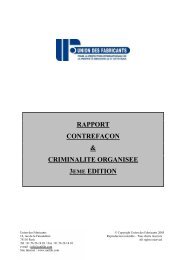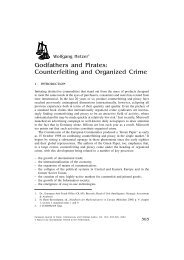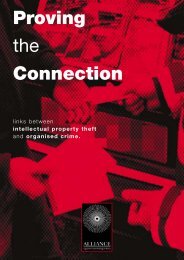counterforce - Counterfeiting
counterforce - Counterfeiting
counterforce - Counterfeiting
You also want an ePaper? Increase the reach of your titles
YUMPU automatically turns print PDFs into web optimized ePapers that Google loves.
<strong>Counterfeiting</strong> Perspectives<br />
<strong>Counterfeiting</strong> - The Global Challenge<br />
for Trademark Enforcement<br />
By Richard Heath, VP Legal - Global Anti-<strong>Counterfeiting</strong> Counsel,<br />
Legal Strategy Group, Unilever Plc<br />
<strong>Counterfeiting</strong> has grown substantially over the years to<br />
become the greatest threat to established brands.<br />
Whereas counterfeiting was viewed in the late 1980s<br />
as mainly affecting luxury brands that had gained<br />
international fame, it is now a global problem touching<br />
all industry sectors. As a result, anything that can be<br />
copied will be.<br />
<strong>Counterfeiting</strong> is a serious crime and international,<br />
regional and national governments need to recognize<br />
this and impose appropriate sanctions on counterfeiters.<br />
Some countries have recognized counterfeiting as a<br />
serious risk for society and acted accordingly but more need to do so.<br />
While criminalization of counterfeiting is probably one of the best ways to deter<br />
counterfeiting, strong customs regimes associated with efficient and quick access to<br />
remedies have proven successful at drawing some concrete results for brand owners.<br />
For example, the establishment of fines, statutory damages and sanctions against<br />
counterfeiters that are commensurate to the harms they cause, would make counterfeiting<br />
a less lucrative and attractive business. In addition, the non-imposition by<br />
customs of a bond requirement as a condition to processing counterfeiting cases,<br />
and improved intelligence sharing would make it easier for brand owners to act against<br />
counterfeiters.<br />
In China the so-called four City Landlord Liability initiative is having some impact<br />
and indeed in Nigeria, where the tort has recently been introduced, NAFDAC (the<br />
Regulatory body for food, drug and healthcare products in that country) claims a 60%<br />
reduction in the level of pharmaceutical counterfeits since its introduction, specifically<br />
targeting pharmaceutical manufacturing facilities. This is an excellent achievement in<br />
a country that is often perceived as one of the worst in Africa for counterfeits.<br />
In addition, secure destruction of counterfeit manufacturing facilities would help,<br />
as very often in China such plants are simply mothballed and re-commissioned as<br />
soon as offenders are released from jail, making re-offence likely. If their significant<br />
investment in machinery had to be repeated this would be a considerable deterrent<br />
against re-offence. This should become part of the asset recovery process.<br />
A number of major partnerships and technical assistance initiatives to help China<br />
and other countries improve their enforcement framework have been undertaken.<br />
Examples include the EU-China and the US-China bilateral co-operation initiatives,<br />
and these are having some impact. Additionally, the China Customs Authority is now<br />
actively engaged in the fight against IP Crime, particularly with respect to exports from<br />
major shipping ports and hubs, and the positive impact of this too is now being felt<br />
reflected in increasing seizures before the consignments leave the ports.<br />
Elsewhere the phenomenon of transshipment, especially through Free Trade Zones<br />
6







